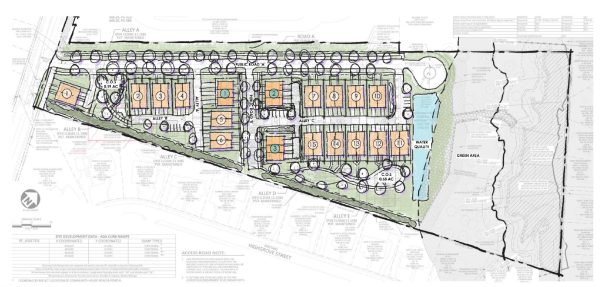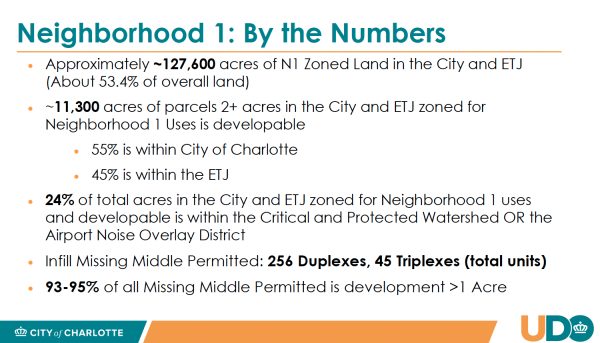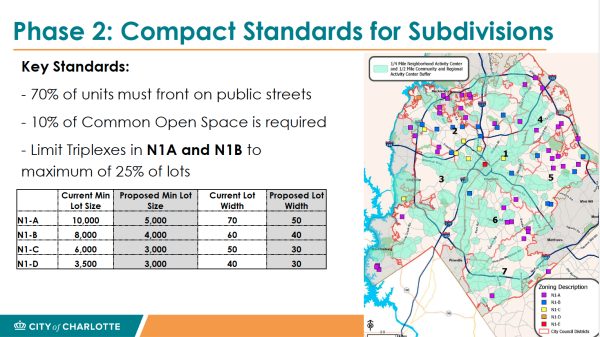New development tool passes easily through committee

This week, the Transportation, Planning, and Development Committee held their June meeting. They discussed a potential new Compact Development standard and received an update from CATS. Couldn’t make the meeting? Here’s a recap!
Key takeaways
- Committee members are in favor of moving forward with staff-recommended Compact Development standards this month.
- If adopted, Compact Development will allow the City to ensure that development is the right size, quantity, and quality for the proposed location. In other words, development will be more likely to occur where necessary infrastructure is already in place.
- CATS ridership is up system wide, including the Gold Line streetcar, which saw an 11.5% increase since April 2023.
- CATS is turning its attention to improving on-time performance for fixed-route bus service from 79.9% to 85%.

Compact Development update
City of Charlotte Planning staff gave a detailed presentation about the proposed Compact Development standard. This new standard would address the quality, quantity, and location of housing in the city while addressing the loophole that was closed with the May 20 adoption of the new Conservation Development standards. They described Compact Development as a “modern tool for increasing housing supply.”
Currently, over half of the land in the city (53.4%) is zoned as N1, or low-density residential. 24% of N1 zoned land is within Critical and Protected Watershed OR Airport Noise Overlay districts, which means that development is already restricted. If adopted, the Compact Development standards will apply to all N1 zoning outside of the two aforementioned districts.
So why is the Compact Development standard needed? It would right-size development to its location, meaning developments would only be built where appropriate infrastructure like streets and sidewalks already exist. Developers will also have the chance to use smaller lot sizes and thus create more units to match existing neighborhood lot sizes and achieve necessary housing density in the right spots.

Here are a few stipulations of the proposed Compact Development standards that were created with input from stakeholders and developers (this is not an exhaustive list):
- 70% of units must front public streets.
- New subdivisions of 2+ acres can reduce lot sizes with additional 10% of usable common open space.
- In N1A and N1B, triplexes are limited to a maximum of 25% of lots.
- Developments must have a public street network that can connect to future development sites.
Watch this information session video to learn more about the Compact Development amendments.
A third text amendment, which will address townhomes in N1 zoning, is planned for fall 2024. City staff will spend the summer researching and engaging with the public about the economic feasibility and land availability for townhomes throughout the city.
There was very little discussion about this proposed development standard and all committee members recommended moving the discussion to the full City Council.
Next steps:
- Public hearing on June 17
- Zoning Committee recommendation on June 20
- City Council decision on June 24
Sustain Charlotte’s take
Compact development makes mass transit economically feasible and allows people to live within walking or bicycling distance to work or school. When we get all of the elements of smart growth right, the result is a city that offers a variety of transportation and housing choices for all who call the Charlotte region home.
We believe that the Compact Development subdivision option will increase housing diversity and density and reduce sprawl. It is important to view this as just one step in a series of measures that will bring Charlotte closer to a smarter growth plan. Subsequent phases will involve improvements to infill development, and, in the coming year, the city may consider realignment rezonings. Our primary objective is to ensure that these changes are carried out in a manner that is consistent with the principles of smart growth, and this proposed new standard is one step on that path.
CATS update
Interim CATS CEO Brent Cagle gave his monthly update to committee members, this time focusing on the light rail truck overhauls, system-wide ridership, and on-time performance.
Over the past year, CATS has been sending light rail vehicles to maintenance facilities in California and Florida to be overhauled. So far, they have received and put back into service six trucks. Another two have been received and are undergoing field testing, and the final two are still in Florida.
Cagle reported that missed trips for all CATS services (buses, light rail, and streetcar) remained under 1% in March and April. This consistent service is most likely due to adequate levels of staffing.
Ridership has also improved since April 2023. Systemwide ridership increased by 18.5%, with the Gold Line showing an 11.5% increase. Cagle shared that CATS ridership is in line with other transit agencies around the country, though it is still not at pre-pandemic levels.
Finally, Cagle announced that CATS staff are now closely watching on-time performance (OTP) of their fixed-route bus service. A 5-minute grace period is given for buses that are early or late, but ultimately, the goal is to improve OTP to the industry standard of 85% of trips. CATS is currently operating bus service at 79.7% while the Gold Line is at 93% and Blue Line is at a remarkable 99%. CATS is working closely with the new transit management group, National Express, to improve bus OTP.
You can watch the meeting recording here and view the agenda here.
Thanks for reading!
As a nonprofit, community support is essential for us to keep doing what we do — including providing free articles like this. If you found this article helpful, please consider supporting Sustain Charlotte.
Want to stay in the loop? Subscribe to our weekly newsletter and follow us on Instagram, Facebook, and X.
